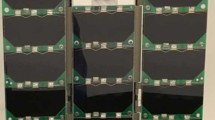Abstract
The X-Ray Telescope (XRT) onboard the Hinode satellite, launched 23 September 2006 by the Japan Aerospace Exploration Agency (JAXA), is a joint mission of Japan, the United States, and the United Kingdom to study the solar corona. In particular, XRT was designed to study solar plasmas with temperatures between 1 and 10 MK with ≈ 1″ pixels (≈ 2″ resolution). Prior to analysis, the data product from this instrument must be properly calibrated and data values quantified to accurately assess the information contained within. We present here the standard methods of calibration for these data. The calibration was performed on an empirical basis that uses the least complicated correction that accurately describes the data while suppressing spurious features. By analyzing the uncertainties remaining in the data after calibration, we conclude that the procedure is successful, because the remaining uncertainty after calibration is dominated by photon noise. This calibration software is available in the SolarSoft software library.
















Similar content being viewed by others
References
Freeland, S.L., Handy, B.N.: 1998, Data analysis with the SolarSoft system. Solar Phys. 182, 497 – 500.
Golub, L., Deluca, E., Austin, G., Bookbinder, J., Caldwell, D., Cheimets, P., et al.: 2007, The X-Ray Telescope (XRT) for the Hinode mission. Solar Phys. 243, 63 – 86.
Janesick, J.: 2001, Scientific Charge-Coupled Devices, SPIE Press Monograph, SPIE, Bellingham.
Kano, R., Sakao, T., Hara, H., Tsuneta, S., Matsuzaki, K., Kumagai, K., et al.: 2008, The Hinode X-Ray Telescope (XRT): Camera design, performance and operations. Solar Phys. 249, 263 – 279.
Kobelski, A., Saar, S., McKenzie, D.E., Weber, M., Reeves, K., DeLuca, E.: 2012, Measuring uncertainties in the Hinode X-Ray Telescope. In: Golub, L., De Moortel, I., Shimizu, T. (eds.) Fifth Hinode Science Meeting, ASP Conf. Ser. 456, 241 – 244.
Kosugi, T., Matsuzaki, K., Sakao, T., Shimizu, T., Sone, Y., Tachikawa, S., et al.: 2007, The Hinode (Solar-B) mission: An overview. Solar Phys. 243, 3 – 17.
Narukage, N., Sakao, T., Kano, R., Hara, H., Shimojo, M., Bando, T., et al.: 2011, Coronal-temperature-diagnostic capability of the Hinode/X-Ray Telescope based on self-consistent calibration. Solar Phys. 269, 169 – 236.
Acknowledgements
Hinode is a Japanese mission developed and launched by ISAS/JAXA, collaborating with NAOJ as a domestic partner, and with NASA and STFC (UK) as international partners. Scientific operation of the Hinode mission is conducted by the Hinode science team organized at ISAS/JAXA. This team mainly consists of scientists from institutes in the partner countries. Support for the post-launch operation is provided by JAXA and NAOJ (Japan), STFC (U.K.), NASA, ESA, and NSC (Norway). This work was supported by NASA under contract NNM07AB07C with the Smithsonian Astrophysical Observatory.
Author information
Authors and Affiliations
Corresponding author
Rights and permissions
About this article
Cite this article
Kobelski, A.R., Saar, S.H., Weber, M.A. et al. Calibrating Data from the Hinode/X-Ray Telescope and Associated Uncertainties. Sol Phys 289, 2781–2802 (2014). https://doi.org/10.1007/s11207-014-0487-9
Received:
Accepted:
Published:
Issue Date:
DOI: https://doi.org/10.1007/s11207-014-0487-9




